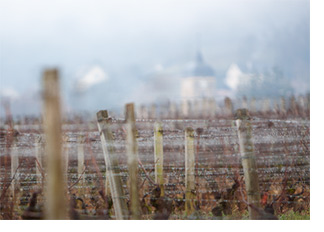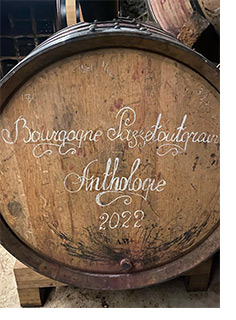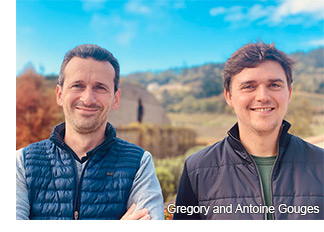 'Bountiful and Beautiful'
'Bountiful and Beautiful'
A tale of timely rains and lovely wines
'A vintage of the kind we were all hoping for', reported the BIVB, the Bourgogne Wine Board: quality and quantity. 'With beautiful balance, perfect health, and wonderful colour extraction, it would be unreasonable to ask for more.' Or, in the words of Jasper Morris MW, a 'bountiful and beautiful harvest'; there are 'very good wines and plenty of them, consistent in both colours and across the region.' But how did this happen? 2022 in Burgundy saw a hot, dry year, a very early harvest, and a rebound from the historically low 2021 crop. The big surprise of the vintage is how this hot year is not reflected in the glass; the wines are fresh and driven and energetic, with an excellent balance between ripeness and acidity. It is arguably all down to June rains that arrived just when they were needed. The reds are bright and lifted and defined by red rather than black fruit notes, and soft, silky tannins. The whites are generous but still precise, focussed, and energetic; it is not unusual to find orchard fruit notes against the more searing lemon and lime. And both the reds and the whites have a vintage-defining salinity to them. María Ignacia Navarro González, the winemaker at Meo-Camuzet, wryly captured this when she joked, 'je n'ai pas chaptalisé, j'ai mis du sel': 'I didn't chaptalize, I added salt'.
The season
2022 fits into the profile of the 'new normal': a mild winter and a warm growing season leading to an early harvest. Winter 2021/2022 was mild and unusually dry. That led to an early start to the growing season, and ultimately set the stage for an early harvest. The first shoots appeared at the start of April. The bugbear of many recent Burgundy vintages has been the April frost and, sure enough, to the alarm of winemakers, early April temperatures dropped sharply. Between 3 and 11 April there were 4 nights of frost. However, at this stage most buds were still sheathed, and while there certainly were some losses to frost, these were nowhere near as extensive as in 2021. Warm weather then set in, speeding up the growth cycle. Flowering happened in mid-May under clear skies. That is ideal, since rain disrupts flowering. (And as pollinated flowers become berries, fewer flowers ultimately means fewer grapes). After flowering, there was a spell of much-needed rain, with dry, sunny conditions returning in time for fruit set (when flowers become grapes). Thunderstorms at the end of June (21-25 June) brought some more much-needed rain, but hail also caused significant damage in some areas (most notably for Uncorked growers, across the Gevrey/Fixin border and in the south of Nuits-St-Georges). The wet conditions around the end of June also brought some mildew pressure, but that was soon burnt off by the dry July heat. Young vines with less developed root systems, or vines in shallow or sandy soils, started to struggle, and some became blocked - it was possible to see vines at quite different stages of development in different vineyards across the region. The majority of vines withstood the hydric stress, which was largely relieved by some timely mid-August rain. It was another 'summer holiday harvest' that for many growers began on 25 August, and finished quite quickly. But for a few addresses on the Cote de Nuits, harvest was prolonged for as late as the third week of September, reflecting the fact that development in ome vineyards had been blocked for part of the summer. As the BIVB reported, harvested grapes were in 'fine condition and wonderful health'. There wasn't a lot of work to do at sorting tables. In the vats, there was a 'surprisingly good' yield of juice, and musts were 'balanced with controlled degrees of alcohol and good acidity.' Alcohol levels will rarely be above 13.5% and there is plenty of freshness thanks to high levels of tartaric acid.
 2020 vs 2022
2020 vs 2022
Almost every winemaker we spoke to compared 2020 and 2022. Both were hot, dry years which culminated in early harvests. 2020 was widely reported as the earliest harvest ever, beating the record that historical research suggested had previously been set in 1580. In 2020 some growers had started bringing in their fruit as early as 15 August. While in 2022 it looked for a while that harvest could be that early, most growers didn't start harvesting before 25 August (which is still very early in the sweep of historical vintages). 2022 was hot and dry, but it was not as hot or as dry as 2020. And crucially, in 2022 it rained when rain was needed. The June and August heat spikes in 2022 were preceded by opportune rains. As Romain Taupenot noted, 'in 2020 we prayed for rain that never came. In 2022, we had rain when we really needed it.'
This difference has given the 2022s a very different character from the 2020s. 2020s were dark and concentrated, with a claret-like density. They showed notes of dark fruit, like blackberry and bramble. In 2022, it's all about red fruit and silky tannins. The wines are less concentrated than in 2020, but have an ethereal intensity. Romain Taupenot said, '2020s were dark and powerful. 2022s have a bit less of everything except balance. They are fresh and harmonious.' Interestingly, 2022s have a little less acidity than the 2020s (when everything was concentrated) but with significantly lower alcohol levels, the perception of freshness is stronger. And as María Ignacia Navarro González noted at Meo-Camuzet, back in 2020 everything tasted great - but the same. When wines reach a certain level of alcohol and concentration, terroir character tends to become masked. By contrast, in 2022 there is an unusually marked sense of terroir differentiation. This was especially true when we tasted white wines. For us, it had never been so easy to differentiate Chassagne-Montrachet (denser), Puligny-Montrachet (racier), Meursault (airy and aromatic), and Saint-Aubin (mineral, tense, precise). In reds, Chambolle-Musigny for once really lived up to its reputation for delicate, lacy wines. Gevrey-Chambertin is tense and muscular, Morey-St-Denis supple and spicy, Vosne-Romanee is elegant and floral, Nuits-St-Georges is full, structured and serious. In many ways 2022 is a textbook Burgundy vintage.
 How good is 2022?
How good is 2022?
'Is 2022 a great vintage?' mused Romain Taupenot. 'We are still at the start of the movie. Time will tell.' He was not the only winemaker to suggest truly great vintages are only visible in retrospect. Most winemakers we spoke to expressed broadly similar sentiments to Etienne Grivot: '2022 is much more serious than it seems. The suavity of the tannins makes it soft and easy to taste, but behind that there is structure and energy.' Ultimately, he gauged that those silky tannins mean this will be a vintage for the medium but not the very long term. In Volnay, Frédérick Lafarge told us straight up he thought 2022 is 'un grand millésime'. He is certainly a winemaker who has a long historical perspective.
Yields
After three consecutive and increasingly small harvests, 2022 welcomed generous yields. Etienne Grivot laid it out for us in terms of the maximum allowed yields. In 2022, he achieved yields averaging 15% below the appellations he worked in.
By contrast:
2019 - yields 30% below the maximum permitted, mainly due to small berries resulting from dry conditions.
2020 - yields 40% below the maximum permitted, as in 2019 mainly due to small and very concentrated berries from hot and dry conditions.
2021 - yields 50% below the maximum permitted, due to frost, rain during flowering, and mildew in the damp summer season.
It can feel as if it is becoming increasingly unusual for the region to achieve what the Burgundians optimistically call 'normal' yields. On the other hand, there is good news on the horizon; yields in 2023 are similar to those in 2022.
 Adapting to the new normal
Adapting to the new normal
'Burgundy and the Rhône are getting nearer,' Romain Taupenot told us. 'We used to have a semi-continental climate, but now we have a continental climate'. In Burgundy in the 1950s, there were two September harvests; the rest were in October. Nowadays, we still expect two September harvests in a decade - except the other eight will start in August. More than people in most walks of life, vignerons come face-to-face with the reality of global warming. This year, everyone seemed to be discussing climate change and 'the new normal': a mild winter which leads to an early start to the season, with the risk of delicate young buds being ambushed by an April frost. Then a hot, dry summer followed by an early harvest.
For many winemakers, 2003 was the watershed vintage, when they had to deal with extremely hot, dry conditions they had never seen before. At the time, it felt like a fluke, but since then heat and drought have become increasingly normal. Once upon a time, vignerons worried about whether they would be able to get their grapes ripe before autumn rains set in. Worrying about sugar ripeness is a thing of the past. Nowadays, vignerons worry about preserving acidity. If it gets really hot, they have to worry about whether phenolic (flavour) ripeness can keep pace with accelerating sugar ripeness. There is also a parallel danger to a hot, dry growing season. Vines that can't get enough water shut down. They stop photosynthesis (which is why the leaves of a dry plant turn yellow) and fruit development, to protect themselves. Acidity stays high and tannins remain bitter. The most misjudged 2003s managed to combine a burnt fruit quality with bitter, unripe tannins resulting from blocked development.
The first and most obvious response to a warm, early season is an early harvest. But there is a big difference between an August harvest and a September or October harvest. In August it is likely to still be very hot, and under those conditions the grapes are changing very fast. This means the picking window becomes a lot shorter - in some cases, a single extra day on the vine can make a big difference to the final wine. Late season harvests have the potential to be quite leisurely, but in what Charles Ballot-Millot calls 'a summer holiday harvest', it's essential to get your picking dates just right. And it's not just a question of choosing the right moment, it's also a logistics question of having pickers in place.
Etienne Grivot picked later than most in 2022. This, he says, is a natural follow-on from deliberately carrying out spring ploughing later than most. Ploughing after winter stirs the soil and encourages the vine to begin its spring cycle. Etienne argued that ploughing later means a slower start to the vines' annual cycle. That means that grapes stay on the vine later in the season, when it is a little cooler. They continue to develop phenolic ripeness and flavour complexity, without acquiring excessive sugar. Not everyone agrees with this approach - Alex Moreau was wary. For one thing, it means ploughing in deep weeds. Ploughing also releases humidity from the soil. If you do that later, when the vine has begun its cycle and buds are appearing, you magnify the risk of frost damage. 'If you plough late, and you get frost the day after you plough, you're dead.' The humidity released by ploughing freezes, and makes the damage from frost much worse. Alex recalls exactly that happening to his father in 1995.
Allowing more cover crops to grow in the vineyard also helps preserve water in the soil. Winemakers used to root out other plants, on the grounds that these would compete with the vine for water. It is now widely accepted that having a vineyard with grass and flowers creates a surface layer that impedes evaporation from the soil, and is better for the vine. Lighter, less invasive spring ploughing disturbs the soil less, and releases less humidity. Allowing humus to decay back into the soil also helps prevent evaporation.
 'So far, we haven't had to start picking at night,' said Cyprien Arlaud, 'but that may happen in the future'. In hotter areas of the wine-producing world (such as Napa) it happens already. It's not a problem to pick grapes when it's hot outside, but you mustn't press grapes when they are hot. In warm Burgundian harvests, it is not now unusual to see grapes going to the winery in refrigerated trucks.
'So far, we haven't had to start picking at night,' said Cyprien Arlaud, 'but that may happen in the future'. In hotter areas of the wine-producing world (such as Napa) it happens already. It's not a problem to pick grapes when it's hot outside, but you mustn't press grapes when they are hot. In warm Burgundian harvests, it is not now unusual to see grapes going to the winery in refrigerated trucks.
While nobody seems to be seriously talking about changing grape varieties to adapt to hotter conditions (yet), many are experimenting with different rootstocks. The bugbear of many Burgundian vineyards these days is 161.49. That's a rootstock, widely planted across the region from the 1980s onwards. It was previously considered by many growers to be the gold standard, disease-resistant and favouring good yields of high-quality fruit. But it turns out that it has one fatal flaw; with a wide but shallow root network, it can't reach deep water reserves, and so doesn't handle drought well. The most vulnerable vines are those planted on thin, well-drained soils - which happens to be the norm in the greatest vineyards. In drier vintages (notably 2015 and especially 2020) a lot of vines planted on this rootstock died. With drought vintages becoming ever more normal, this problem is only going to become worse. By some estimates, up to 10% of the total vineyard area in Burgundy may need to be replanted in the upcoming years to replace 161.49. The big question is: what to replace it with? There are a variety of local rootstocks that are good candidates; some growers are looking further afield. Romain Taupenot is experimenting with southern French rootstocks. From dry areas, these have root networks that are used to burrowing deep in search of water.
2022 was hot and dry, but the wines are fresh and lifted, mineral and saline, very 'Burgundian'. We heard a fairly general consensus that without the experience of 2003, the 2022s would never have turned out so well - winemakers have been on a steep learning curve since then. There is a more controversial theory that the vines themselves are adapting how they respond to hotter, drier conditions. When cool nights are succeeded by hot days, dew forms on vines. The dew evaporates too quickly to get into the soil, but it is notable nonetheless that at times when dew was prevalent, vines suffered less from hydric stress. Cyprien Arlaud claimed that the vines are becoming better at absorbing that dew through the pores in their leaves.
As Cyprien also noted, 'global warming isn't just happening in the vineyard, it's happening in the cellar.' He argued that it is more important than ever to monitor and maintain both temperature and humidity in the cellar. It is just as important to control the quality and the quantity of the lees the wine is left on, as these may interact differently with the wine as the cellar warms up. Cellar temperature should also be borne in mind when it comes to racking and bottling.
For all the worries about global warming and its impact on the region, though, more than a few winemakers wanted to stress that thus far it has been a good thing for Burgundy. If you consider the last 40-50 years in Burgundy, Romain Taupenot pointed out, the wines have never been so good. They now reliably achieve ripeness. (Wines are also better now because in the past, many wineries were far less fussy about sorting out poor quality fruit, with mouldy fruit often freely ending up in vats). At Marc Colin, Damien reluctantly admitted that global warming had been great for Saint-Aubin - the wines of the village have never been so good. On the other hand, as he was quick to point out, Saint-Aubin is at its best now and global warming needs to stop - any more will push the pendulum the other way.
2022, a win for whole bunch
One of the defining debates around red Burgundy in recent years has been about whole bunch vinification - that is, using a proportion of grape bunches (stems and all) in the fermentation vat, as opposed to destemming the grapes. Prior to the Second World War, almost all winemaking would have inevitably involved whole bunch fermentation; hand-destemming of grapes was too labour-intensive for winemaking except on a small scale. Then the invention of mechanical destemmers changed the way wine could be made. The late, great Henri Jayer convinced a generation of Burgundians they needed to destem all their grapes; more recently, there has been a reappraisal of the advantages using stems (or more usually, a proportion of stems).
The proponents of destemming grapes argue that it gives wine a purer fruit character, and avoids the danger of the bitter flavours than can be imported from underripe stems. That's a real danger - stems ripen later than fruit, so while your grapes may be perfectly ripe, that doesn't mean the stems are. The advocates of using whole-bunch fruit say it brings both freshness and complexity to a wine. Detractors will say that whole-bunch fermentation can bring a 'stemmy' character to a wine that many tasters find unappealing (though that character should resolve with age).
One thing I found striking and confusing about 2022 Burgundy is that while more domaines than ever seem to have used a proportion of whole bunch in their ferments, there was not one domaine we tasted at where we found an unpleasant stemmy character in the wine. We did find many where the exuberant aromatics of a successful whole-bunch approach were on show. This made a big contrast with 2020, when I found stemminess more intrusive in the wines; it seems that the less-concentrated 2022 has favoured a whole bunch approach.
The best explanation I heard for the whole bunch conundrum this year came from Jacques Desvauges at Domaine des Lambrays. His Morey-St-Denis uses no whole bunch, the Morey St-Denis Les Loups uses 50% and the Clos des Lambrays uses a whopping 80%. That spread broadly reflects the spread of old vines across the domaine. None of the wines showed any stemmy character. Jacques explained to us that he only uses whole bunch on older vines, where the berries are naturally smaller - his criterion is whether the berries are small enough for him to be able to see through to the stem inside the bunch. Using only the old vines means he can capture the exuberant, complex aromatics whole bunch can bring, without also bringing on board any obvious stemmy character.
And the gong goes to…
One French veteran of the tasting rooms explained his philosophy of judging chefs to us. 'You should never judge a chef by what they can do at la grande table. You should judge them by their cheapest, most basic menu du jour. That is where you where you can see how good a chef is.' Similarly, he told us, you should never judge a Burgundian producer by their grand crus, but by their basic Bourgogne. Judged by that standard, it is easy to call 2022. From the addresses we tasted at (all favourite Uncorked producers) the best Bourgogne Rouge was made by Cyprien Arlaud (his Bourgogne Roncevie) and the best Bourgogne Blanc was by Alex Moreau.
 Show us the money
Show us the money
We don't yet know where prices will land for 2022 Burgundy. Winemakers still grumble about their costs. Louis Fourrier noted that a style of barrel that cost his family domaine 700 euros two years ago now costs 900 euros; Gilbert Felettig (who buys in grapes for his negoce label) complained that despite the generous recent yields in 2023 (as well as 2022) the wholesale cost of grapes is as high as it ever has been. Louis Fourrier complained about a 'large company' that recently bought one-eighth of a hectare of Griotte-Chambertin for 9 million euros. Escalating vineyard prices can be an existential threat for family domaines. They will face huge inheritance tax demands based on high land values, and may be forced to sell to meet these. The next generation may see an increasing number of domaines moving to a more Bordeaux-style corporate ownership model.
Coming soon to a wine merchant near you
We'll be offering 2022 Burgundy from January. For the first time in a few years, we also hope to have enough samples to run an in-store tasting. As ever, when it comes to the most desirable wines, we will give priority to previous purchasers, but we will always try and look after good Uncorked customers - and of course, we will be only too delighted to welcome new customers on board. We'll be happy to help, and to offer transparent opinions. /NT